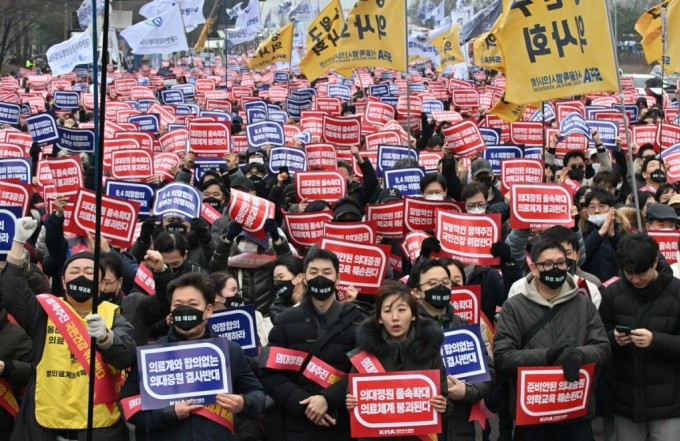Returning home after a 12-hour shift at Seoul National University Hospital (SNU), Dr. Nguyen quickly ate a bowl of rice and stayed up until early morning to complete his homework.

Dr. Nguyen's routine has lasted for 3 weeks now, making the woman feel that this is the "most stressful and busiest" period since arriving in Korea (2022).
At the hospital, the main task of Dr. Luong Pham Hanh Nguyen, 36 years old, is to assist professors in examining patients, taking medical records, and participating in consultations. Her work and daily schedule used to be stable, usually starting from 9am to 12pm. After that, she rests for an hour to prepare for the afternoon shift, from 1pm to 6pm. In the evening, the woman has time to relax and take care of herself.
Since February 20, when the general strike of resident doctors took place, Seoul National University Hospital - one of the most prestigious medical institutions in the country - has been affected. This is a practice hospital, combining the training of resident doctors with the examination and treatment of patients.
However, for nearly a month now, many residents and interns have left their jobs. Patients have increased, medical staff has decreased, and the backlog of work has been shared by professors, students, and the remaining doctors. Doctor Nguyen has gradually gotten used to working 15-16 hour days, sometimes working through lunch and forgetting to eat. Many tasks that were not previously her duties are now assigned directly by the professor.
"This is the common situation of doctors in my department: Overwork. There are professors who, even though they are sick, still try to go to school to work because if they take time off, no one will treat patients," Dr. Nguyen shared.
The conflict between the government and the striking doctors has become more tense as authorities have begun revoking the licenses of nearly 5,000 doctors and warned of possible criminal proceedings. In response, SNU professors plan to resign en masse on March 11. Medical professors at Catholic University have also warned that they will continue to suspend surgeries and reduce treatment for both inpatients and outpatients.
Dr. Nguyen Hai Dang (name has been changed), Department of Surgery, Bundang Hospital, Seoul National University, is also affected by the crisis. Having been in Korea for two months, Dang is eager to learn a lot of knowledge and clinical experience from doctors in this country. However, many medical staff at Bundang Hospital are currently on strike, affecting treatment work.
Mr. Dang said the number of patients still poured in, but due to the lack of support staff, the professors, who are also the main treatment staff at the hospital, could not perform many surgeries. Previously, the Department of Surgery performed an average of 30 to 40 surgeries per day, divided into about three to four operating tables. Now, the number of surgeries has dropped to two to three per day. More specialized departments such as Craniofacial Surgery do not even perform any surgeries.
The situation of "not being able to see patients" made Mr. Dang feel "not as lucky" as the previous Vietnamese doctor. "If the hospital was operating normally, I would be able to help the professor prepare medical records, consult, assist in surgery, and many other tasks," the doctor said, adding that this situation made him feel somewhat disappointed.
However, both Dr. Nguyen and Dang understood their colleagues' decision to strike. According to Dr. Nguyen, those on strike are usually medical specialists who work 80 to 100 hours a week. Sometimes, they only go home to sleep for about two hours, then return to the hospital to continue working the next morning, "very tired and stressed."
Master Nguyen Phuong Thuy, a doctoral student at the Department of Microbiology and Immunology, Faculty of Medicine, Seoul National University, agrees with this view. According to Ms. Thuy, Korea often lacks doctors in essential specialties, also known as treating doctors. Medical students tend to choose dermatology and aesthetics after graduation, because the work is easy and the salary is high. While if the quota is increased, the competitive pressure in popular majors will be higher, but essential majors still suffer from a shortage of doctors.
From this reality, the striking doctors hope that the government will increase the treatment of essential medical staff at the lower levels; increase investment in modern equipment and machinery for public hospitals, and attract good personnel here, instead of just "rushing into hot industries".

The South Korean government decided on March 13 to provide 94.8 billion won ($72.2 million) to public hospitals this year to address the chronic shortage of medical staff. The health ministry also urged medical professors not to resign, adding that “the government is ready to sit at the negotiating table” to resolve the crisis.
Meanwhile, doctors Nguyen and Dang encourage themselves every day to study and research, sacrificing time and effort to support the hospital.
"If I also quit, who will treat the patients?", Ms. Nguyen said, sharing her wish that doctors and colleagues will quickly return to work, and that the Korean government will make decisions to turn the situation around, so that patients will not be affected.
The 24-day strike by South Korean medical residents stems from the government’s plan to increase the number of medical students by 2025, as the country has the lowest doctor-to-population ratio among developed countries. The move will improve medical services in remote areas and meet the needs of a rapidly aging population.
Contrary to the government’s view, resident doctors say the country does not need more doctors because there are already enough, and that increasing enrollment will reduce the quality of training and medical services, arguing that the population is declining and that Koreans have easy access to medical services. They call on the government to address low salaries and benefits, and improve legal protections against excessive medical malpractice lawsuits, rather than dramatically increasing the quota.
TT (according to VnExpress newspaper)